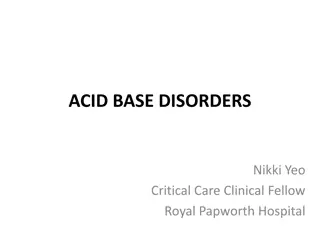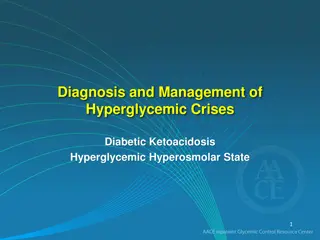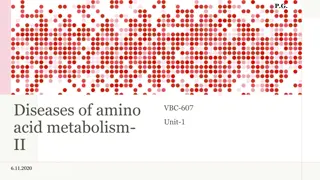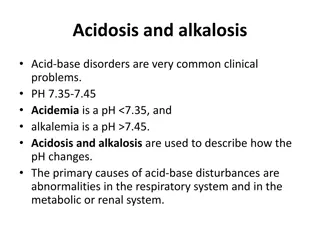Understanding Shock: Causes, Symptoms, and Stages
Shock is a critical condition caused by an imbalance between cellular oxygen supply and demand, leading to organ dysfunction. Compensatory responses include increased heart rate, vasoconstriction, and hormonal adjustments. Recognizable features of shock include tachycardia, hypotension, cool clammy
3 views • 27 slides
Diabetic Ketoacidosis: Understanding Metabolic Acidosis in Diabetes
Explore a case study on diabetic ketoacidosis to understand the basis of metabolic acidosis in type 1 diabetes mellitus, differentiate between type 1 and type 2 diabetes, predict blood buffer equilibrium changes, apply Winter's formula, correlate clinical data with biochemical tests, explain insulin
3 views • 34 slides
Understanding Aspirin Toxicity: Overview and Management
Aspirin toxicity, though decreasing in incidence, can still result in severe consequences such as metabolic acidosis, seizure, and even death. This condition is often underestimated due to lack of familiarity with its clinical presentation. Treatment focuses on maintaining salicylate in the ionized
0 views • 22 slides
Understanding Acid-Base Balance in Health and Disease
Many critical illnesses can disrupt acid-base balance, indicating underlying diseases or organ damage. Interpretation of disturbances requires analyzing arterial blood gases, plasma electrolytes, and compensatory mechanisms. Acid-base disorders are classified into respiratory acidosis, respiratory a
3 views • 26 slides
Understanding Shock and Blood Transfusion in Surgery
Shock is a state of low tissue perfusion leading to metabolic changes like anaerobic metabolism and acidosis. As cellular hypoxia progresses, immune and coagulation responses are activated, impacting cardiovascular, respiratory, renal, and endocrine systems. Shock can be classified into hypovolaemic
0 views • 38 slides
Diagnosis Criteria for Perinatal Asphyxia
Perinatal asphyxia refers to the interruption of oxygen supply to the fetus or newborn, leading to metabolic consequences and potential multiorgan dysfunction and long-term neurological issues. The American Academy of Pediatrics (AAP) and the American College of Obstetrics and Gynecology (ACOG) have
0 views • 12 slides
Decoding Oxidative Decarboxylation and Krebs Cycle in Energy Metabolism
Explore the intricate processes of oxidative decarboxylation and the Krebs Cycle, essential pathways in cellular energy metabolism. Learn about the conversion of pyruvate to acetyl-CoA, regulatory mechanisms, clinical implications, and more. Discover the fates of pyruvate, allosteric regulation, and
6 views • 19 slides
Understanding Acid-Base Disorders in Critical Care
Explore the intricate details of acid-base disorders, including metabolic acidosis with anion gap, high and normal anion gap metabolic acidosis, causes of lactic acidosis, and important considerations like hypoalbuminemia. Learn about the delta ratio and how to interpret it in the context of acid-ba
0 views • 31 slides
Understanding Local Anesthesia and Nerve Conduction Blockade
Local Anesthetics (LAs) are drugs that abolish sensations like pain in specific body areas by blocking nerve conduction of sensory impulses. This process involves reducing the influx of sodium ions, preventing membrane depolarization, and inhibiting action potential conduction. LAs are weak bases wi
0 views • 22 slides
Acute Diabetic Ketoacidosis in a 19-Year-Old Male
Acute presentation of a 19-year-old man with diabetic ketoacidosis (DKA) characterized by hyperglycemia, anion-gap acidosis, and ketosis. Clinical findings include dehydration, hyponatremia, hypotension, altered consciousness, and abdominal pain. Immediate management involves ABCs, fluid resuscitati
0 views • 16 slides
Understanding and Managing Hyperglycemic Crises: DKA and HHS
Hyperglycemic crises such as Diabetic Ketoacidosis (DKA) and Hyperglycemic Hyperosmolar State (HHS) are life-threatening emergencies characterized by severe hyperglycemia and metabolic imbalances. DKA involves absolute or near-absolute insulin deficiency leading to ketone body production and systemi
0 views • 82 slides
Examination of Rumen Fluid and Methods of Collection
The examination of rumen fluid is crucial for diagnosing rumen diseases and for therapeutic purposes like transfaunation. Various physical and chemical characteristics are analyzed, including color, consistency, pH levels, and sedimentation activity. Abnormal findings indicate different health issue
0 views • 17 slides
Understanding Malignant Hyperthermia: Causes, Management, and Epidemiology
Malignant Hyperthermia (MH) is a genetic disorder of skeletal muscle triggered by certain anesthetics, leading to a hyper-metabolic state. The uncontrolled release of calcium results in muscle rigidity, metabolic acidosis, hyperthermia, and other serious complications. MH was first described in the
0 views • 24 slides
Understanding Maple Syrup Urine Disease and Albinism
Maple Syrup Urine Disease (MSUD) is a metabolic disorder affecting the breakdown of branched-chain amino acids, leading to severe symptoms like physical and mental retardation, sweet-smelling urine, and metabolic acidosis. Treatment involves dietary restrictions and potential gene therapy. Albinism,
0 views • 16 slides
Understanding Acid-Base Balance Disorders: Respiratory Acidosis Overview
Acid-base balance disorders manifest as metabolic and respiratory imbalances with distinct characteristics. Respiratory acidosis, a common condition, stems from impaired alveolar ventilation, leading to elevated CO2 levels and decreased pH. It can be acute or chronic, each presenting unique features
0 views • 16 slides
Understanding Haemorrhage and Its Impact in Surgery
Haemorrhage in surgery is a critical phenomenon leading to hypovolaemic shock, trauma-induced coagulopathy, and other complications. It involves ongoing bleeding, hypoperfusion, acidosis, and hypothermia, exacerbating the condition. Classification includes revealed and concealed haemorrhage, with pr
0 views • 33 slides
Understanding Acidosis and Alkalosis in Acid-Base Disorders
Acid-base disorders, involving acidosis and alkalosis, are common in clinical practice. These conditions are characterized by changes in pH levels, with acidemia (pH < 7.35) and alkalemia (pH > 7.45) representing acidosis and alkalosis, respectively. The primary causes of these imbalances lie within
0 views • 17 slides
















